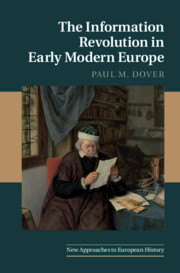Book contents
- The Information Revolution in Early Modern Europe
- New Approaches to European History
- The Information Revolution in Early Modern Europe
- Copyright page
- Dedication
- Contents
- Figures
- Acknowledgments
- 1 Introduction
- 2 European Paper
- 3 “Ink-Stained Fingers”
- 4 The Paper of Politics and the Politics of Paper
- 5 Revolutionary Print
- 6 The Book of Nature and the Books of Man
- 7 Writing Others and the Self
- 8 Conclusion
- Bibliography
- Index
4 - The Paper of Politics and the Politics of Paper
Published online by Cambridge University Press: 24 September 2021
- The Information Revolution in Early Modern Europe
- New Approaches to European History
- The Information Revolution in Early Modern Europe
- Copyright page
- Dedication
- Contents
- Figures
- Acknowledgments
- 1 Introduction
- 2 European Paper
- 3 “Ink-Stained Fingers”
- 4 The Paper of Politics and the Politics of Paper
- 5 Revolutionary Print
- 6 The Book of Nature and the Books of Man
- 7 Writing Others and the Self
- 8 Conclusion
- Bibliography
- Index
Summary
Peter Burke has suggested that the “paper state” was an invention of early modern Europe. It was a function chiefly of the desire of early modern sovereigns for information, about the people they ruled, the competitors they faced, and the events they lived through. With the widespread adoption of paper as a container for that information, the institutions of state in Europe were increasingly mediated through the circulation of paper instruments, chiefly the correspondence of the agents of state power: diplomats, governors, intendants, and other officials who embodied and projected state authority. One of the most evident measurables of the much-talked-about “rise of the modern state” was the state’s consumption of paper.
- Type
- Chapter
- Information
- The Information Revolution in Early Modern Europe , pp. 91 - 148Publisher: Cambridge University PressPrint publication year: 2021

